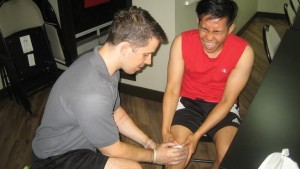A subluxation is a partial dislocation of the kneecap or patella. When the thigh muscles are weak, the patella is not properly held by the surrounding tendons and ligaments or there is problem with the alignment or structure of the bones found in the knee.
A patellar subluxation feels as if the kneecap is changing and congested, but it returns to its normal position by itself. Repeated accidents can damage the cartilage that is found at the back of the patella or stretch the connective ligaments.
Symptoms of patellar subluxation

- There is intense pain that can be felt in the area around the knees. The pain becomes severe when the individual tries to move the affected knee.
- A quick swelling of the knee joint and the affected joint may look enlarged or puffy as well as tender to touch. The damaged tissue that is triggered by patellar subluxation can result to bruising of the skin that surrounds the knee. Bruising will occur once the blood accumulates under the skin surface and causes the affected area to appear red, blue or purple in color.
- If the tendons of the knee slip out place, the knee joint can become unstable and there is difficulty in placing weight on the affected knee while standing or walking. Placing weight on the affected knee can increase the risk of making the affected person lose his/her balance or fall down.
- There is evident deformity in the knee
- Clicking or popping sound when straightening the legs
Dislocation of the kneecap is caused by the improper alignment of the kneecap and it is corrected through strengthening exercises and therapy. Subluxation can also happen through forced leg straightening.
Treatment and home remedies
You can readily ease the symptoms if you will register for first aid training today.
- Rest the knee at least for a few days and avoid engaging in form of intense activity
- Apply an ice pack over the affected area in order to minimize the pain and swelling for 20-30 minutes every 3-4 hours at least for 2-3 days or until the pain is gone.
- You can utilize an elastic bandage, strap or sleeves in order to minimize swelling and for added support.
- Elevate the knee with a cushion or pillow when he/she is sitting down and lying down in order to reduce the swelling.
- Provide the individual with anti-inflammatory medications to help minimize the swelling and pain.
- Perform some stretching and strengthening exercises.
Preventing patellar subluxation
- Always use a kneepad in order prevent bursitis from developing.
- Stop doing any exercise when there pain in the knee starts.
- Stretching the legs before and after engaging in any physical activity.
- Gradually increase the intensity of the workout.
- Perform regular stretching and strengthening in order to keep the thigh muscle strong.
